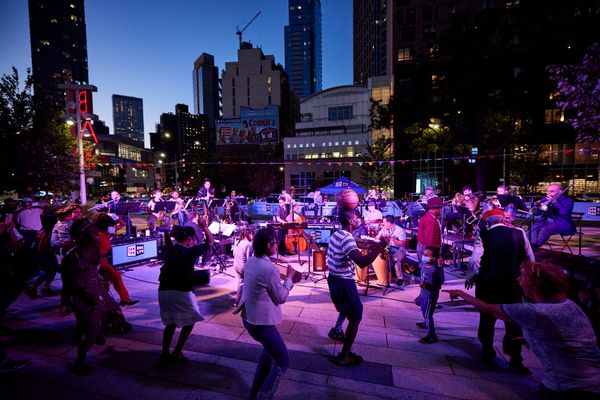We’re Not Under a Rock, Mayor Adams, We’re on a Shrinking One

After seven inches of rain punished New York City on Friday, Mayor Eric Adams took almost a whole day to make his first comments about a storm that effectively ground his city, the country’s largest, to a halt. After having seven separate public events without acknowledging the storm, Adams finally commented, lashing out at the populace, that you would have to be living “under a rock” not to have known the storm was coming.
If that’s so, Mayor Adams, why was the city so unprepared?
Hours after the rain stopped, I rode my bike through Brooklyn’s Prospect Park, the southwest corner of which was still a rapidly moving stream more than a full foot deep. Elsewhere in Brooklyn (and in the rest of the boroughs), water cascaded through basement apartments and school buildings, some of which are built below current sea levels.
We are not living under a rock, Mr. Mayor. We are living on one.
Well, four rocks, specifically, all of which are getting smaller. Manhattan, famously, is a small island, mostly granite bedrock. So are Brooklyn and Queens, the westernmost parts of Long Island. Staten Island is not just a clever name. All of these pieces of rock are shrinking, materially, for the rest of our lives, and for the rest of our children’s lives. The city and FEMA have public interactive maps, where you can see which parts of the city are most vulnerable to continuous coastal flooding, explaining why large parts of our city are, quite literally, already underwater.
This coastal flooding, the kind we experienced last week, will continue to get worse as the climate continues to change. If New York City’s infrastructure cannot handle our current reality, how will it ever deal with what’s coming? We, this large, dysfunctional city in this even larger, even more dysfunctional country, are uniquely vulnerable to persistent coastal flooding. Our old subway system becomes almost unusable, its tunnels serving as de facto channels for whirlpools of sewage. Days after the biggest rainfall, Woodhull Hospital in Bed-Stuy still has no power and is evacuating patients.
Meanwhile, a striking share of our city’s real estate is built below sea level. We may not weep for the wealthy corporate landlords who have to stop squeezing tenants into damp basements, but mom-and-pop brownstone owners also depend on rental income, not to mention the renters with the least leverage, who get shoved into dangerous dwellings. The last apartment I rented in this city was a “garden-basement duplex”; it flooded multiple times per year, often for weeks at a time, despite the landlord installing increasingly loud and intrusive sump pumps. I got out easy though, as living underwater is not just inconvenient, it can be deadly.
It’s possible to do better, though, as when the floods were imminent, Noah built an ark. New York is just one of many global, rich, coastal cities that will lose part of its footprint due to climate change; places with comparable geographies to ours are ahead in the mitigation and resilience game. It’s hard to know what exactly will work here, but some combination of drainage, seawalls, and locks seems like the inevitable course that New York must take. Unfortunately, our leaders’ priorities are elsewhere. In New York’s last ten-year capital budget, the single largest expenditure was not coastal resilience, fixing the subway tunnel infrastructure, or improving street level drainage, but jails. Four of the largest jails in the world, actually, one of which will loom over Downtown Brooklyn and Gowanus, where every modest rainfall seems to conjure a contemporary odyssey, just replace Scylla and Charybdis with 4th Avenue & Dean Street.
We’re not living under a rock, Mayor Adams. We’re living on a shrinking one.
As I surveyed the damage around Prospect Park earlier, I saw a river of trash and dead rats cascading down the newly repaved bike lane on the east side of Prospect Park. That new lane has been a gift to pedestrians and cyclists alike. Credit where credit is due, the parks infrastructure in this city is stronger than it has been in decades.
None of that matters, though, when those parks are literally underwater.
The floods we saw on Friday are the least bad we’ll see in our lifetimes, but Eric Adams, like administrations before his, is just fiddling in the bike lane. Mr. Mayor, since you apparently think prayer is a valid public policy response to real world issues, I have some advice for you before you’re up for re-election: pray for less rain.
Meanwhile, let’s start building an ark.
Justin Cohen is a Brooklyn-based author and activist. Photo by Kelli Kolodny



